Workplace Health and Safety: Safe Practices for Direct Client Care
VerifiedAdded on 2023/06/09
|29
|9589
|425
Homework Assignment
AI Summary
This assignment provides a detailed exploration of safe work practices within a healthcare setting, specifically focusing on direct client care. It begins by outlining workplace policies and procedures related to health and safety, emphasizing the roles and responsibilities of different personnel. The assignment then delves into the identification of potential hazards, including electrical, equipment, and manual handling risks, using case studies to illustrate real-world scenarios. It covers incident reporting, manual handling techniques, and control measures to minimize risks. Furthermore, the assignment addresses infection control, workplace health and safety (WHS) issues, and the development and implementation of policies to promote a safe working environment. It also touches upon maintaining currency of safe work practices, managing stress and fatigue, and the importance of sustainability in healthcare. The assignment concludes with references to support the information presented.
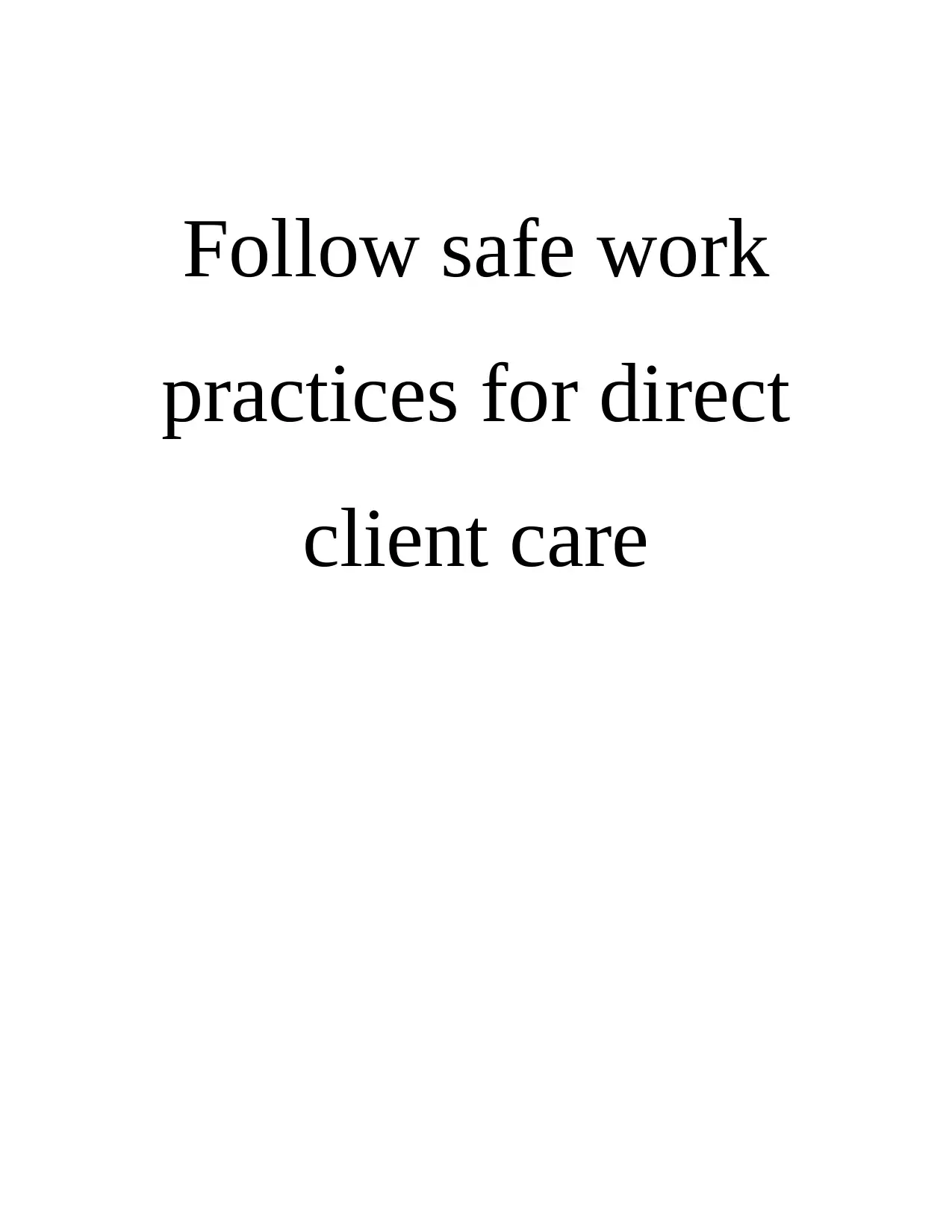
Follow safe work
practices for direct
client care
practices for direct
client care
Paraphrase This Document
Need a fresh take? Get an instant paraphrase of this document with our AI Paraphraser
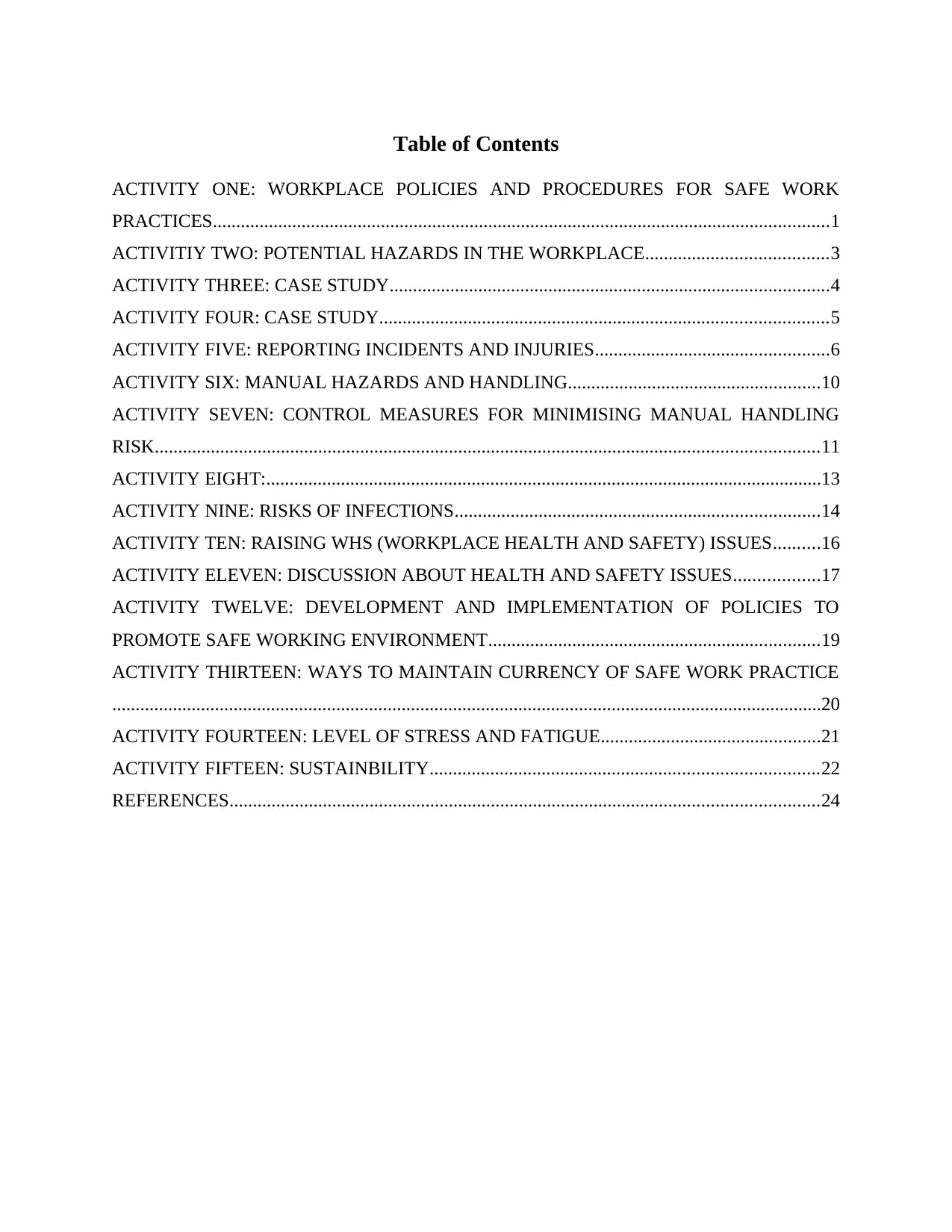
Table of Contents
ACTIVITY ONE: WORKPLACE POLICIES AND PROCEDURES FOR SAFE WORK
PRACTICES....................................................................................................................................1
ACTIVITIY TWO: POTENTIAL HAZARDS IN THE WORKPLACE.......................................3
ACTIVITY THREE: CASE STUDY..............................................................................................4
ACTIVITY FOUR: CASE STUDY................................................................................................5
ACTIVITY FIVE: REPORTING INCIDENTS AND INJURIES..................................................6
ACTIVITY SIX: MANUAL HAZARDS AND HANDLING......................................................10
ACTIVITY SEVEN: CONTROL MEASURES FOR MINIMISING MANUAL HANDLING
RISK..............................................................................................................................................11
ACTIVITY EIGHT:.......................................................................................................................13
ACTIVITY NINE: RISKS OF INFECTIONS..............................................................................14
ACTIVITY TEN: RAISING WHS (WORKPLACE HEALTH AND SAFETY) ISSUES..........16
ACTIVITY ELEVEN: DISCUSSION ABOUT HEALTH AND SAFETY ISSUES..................17
ACTIVITY TWELVE: DEVELOPMENT AND IMPLEMENTATION OF POLICIES TO
PROMOTE SAFE WORKING ENVIRONMENT.......................................................................19
ACTIVITY THIRTEEN: WAYS TO MAINTAIN CURRENCY OF SAFE WORK PRACTICE
........................................................................................................................................................20
ACTIVITY FOURTEEN: LEVEL OF STRESS AND FATIGUE...............................................21
ACTIVITY FIFTEEN: SUSTAINBILITY...................................................................................22
REFERENCES..............................................................................................................................24
ACTIVITY ONE: WORKPLACE POLICIES AND PROCEDURES FOR SAFE WORK
PRACTICES....................................................................................................................................1
ACTIVITIY TWO: POTENTIAL HAZARDS IN THE WORKPLACE.......................................3
ACTIVITY THREE: CASE STUDY..............................................................................................4
ACTIVITY FOUR: CASE STUDY................................................................................................5
ACTIVITY FIVE: REPORTING INCIDENTS AND INJURIES..................................................6
ACTIVITY SIX: MANUAL HAZARDS AND HANDLING......................................................10
ACTIVITY SEVEN: CONTROL MEASURES FOR MINIMISING MANUAL HANDLING
RISK..............................................................................................................................................11
ACTIVITY EIGHT:.......................................................................................................................13
ACTIVITY NINE: RISKS OF INFECTIONS..............................................................................14
ACTIVITY TEN: RAISING WHS (WORKPLACE HEALTH AND SAFETY) ISSUES..........16
ACTIVITY ELEVEN: DISCUSSION ABOUT HEALTH AND SAFETY ISSUES..................17
ACTIVITY TWELVE: DEVELOPMENT AND IMPLEMENTATION OF POLICIES TO
PROMOTE SAFE WORKING ENVIRONMENT.......................................................................19
ACTIVITY THIRTEEN: WAYS TO MAINTAIN CURRENCY OF SAFE WORK PRACTICE
........................................................................................................................................................20
ACTIVITY FOURTEEN: LEVEL OF STRESS AND FATIGUE...............................................21
ACTIVITY FIFTEEN: SUSTAINBILITY...................................................................................22
REFERENCES..............................................................................................................................24
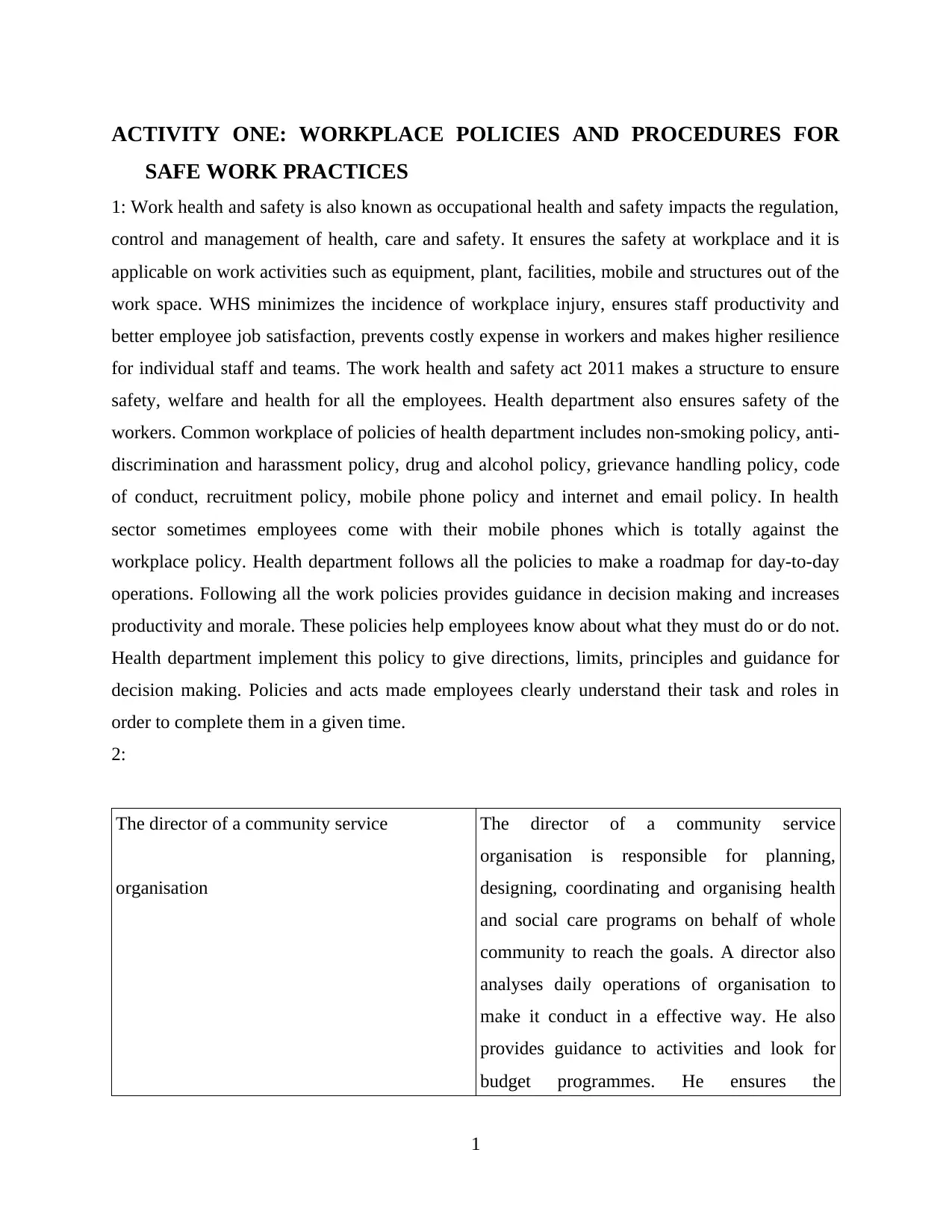
ACTIVITY ONE: WORKPLACE POLICIES AND PROCEDURES FOR
SAFE WORK PRACTICES
1: Work health and safety is also known as occupational health and safety impacts the regulation,
control and management of health, care and safety. It ensures the safety at workplace and it is
applicable on work activities such as equipment, plant, facilities, mobile and structures out of the
work space. WHS minimizes the incidence of workplace injury, ensures staff productivity and
better employee job satisfaction, prevents costly expense in workers and makes higher resilience
for individual staff and teams. The work health and safety act 2011 makes a structure to ensure
safety, welfare and health for all the employees. Health department also ensures safety of the
workers. Common workplace of policies of health department includes non-smoking policy, anti-
discrimination and harassment policy, drug and alcohol policy, grievance handling policy, code
of conduct, recruitment policy, mobile phone policy and internet and email policy. In health
sector sometimes employees come with their mobile phones which is totally against the
workplace policy. Health department follows all the policies to make a roadmap for day-to-day
operations. Following all the work policies provides guidance in decision making and increases
productivity and morale. These policies help employees know about what they must do or do not.
Health department implement this policy to give directions, limits, principles and guidance for
decision making. Policies and acts made employees clearly understand their task and roles in
order to complete them in a given time.
2:
The director of a community service
organisation
The director of a community service
organisation is responsible for planning,
designing, coordinating and organising health
and social care programs on behalf of whole
community to reach the goals. A director also
analyses daily operations of organisation to
make it conduct in a effective way. He also
provides guidance to activities and look for
budget programmes. He ensures the
1
SAFE WORK PRACTICES
1: Work health and safety is also known as occupational health and safety impacts the regulation,
control and management of health, care and safety. It ensures the safety at workplace and it is
applicable on work activities such as equipment, plant, facilities, mobile and structures out of the
work space. WHS minimizes the incidence of workplace injury, ensures staff productivity and
better employee job satisfaction, prevents costly expense in workers and makes higher resilience
for individual staff and teams. The work health and safety act 2011 makes a structure to ensure
safety, welfare and health for all the employees. Health department also ensures safety of the
workers. Common workplace of policies of health department includes non-smoking policy, anti-
discrimination and harassment policy, drug and alcohol policy, grievance handling policy, code
of conduct, recruitment policy, mobile phone policy and internet and email policy. In health
sector sometimes employees come with their mobile phones which is totally against the
workplace policy. Health department follows all the policies to make a roadmap for day-to-day
operations. Following all the work policies provides guidance in decision making and increases
productivity and morale. These policies help employees know about what they must do or do not.
Health department implement this policy to give directions, limits, principles and guidance for
decision making. Policies and acts made employees clearly understand their task and roles in
order to complete them in a given time.
2:
The director of a community service
organisation
The director of a community service
organisation is responsible for planning,
designing, coordinating and organising health
and social care programs on behalf of whole
community to reach the goals. A director also
analyses daily operations of organisation to
make it conduct in a effective way. He also
provides guidance to activities and look for
budget programmes. He ensures the
1
⊘ This is a preview!⊘
Do you want full access?
Subscribe today to unlock all pages.

Trusted by 1+ million students worldwide
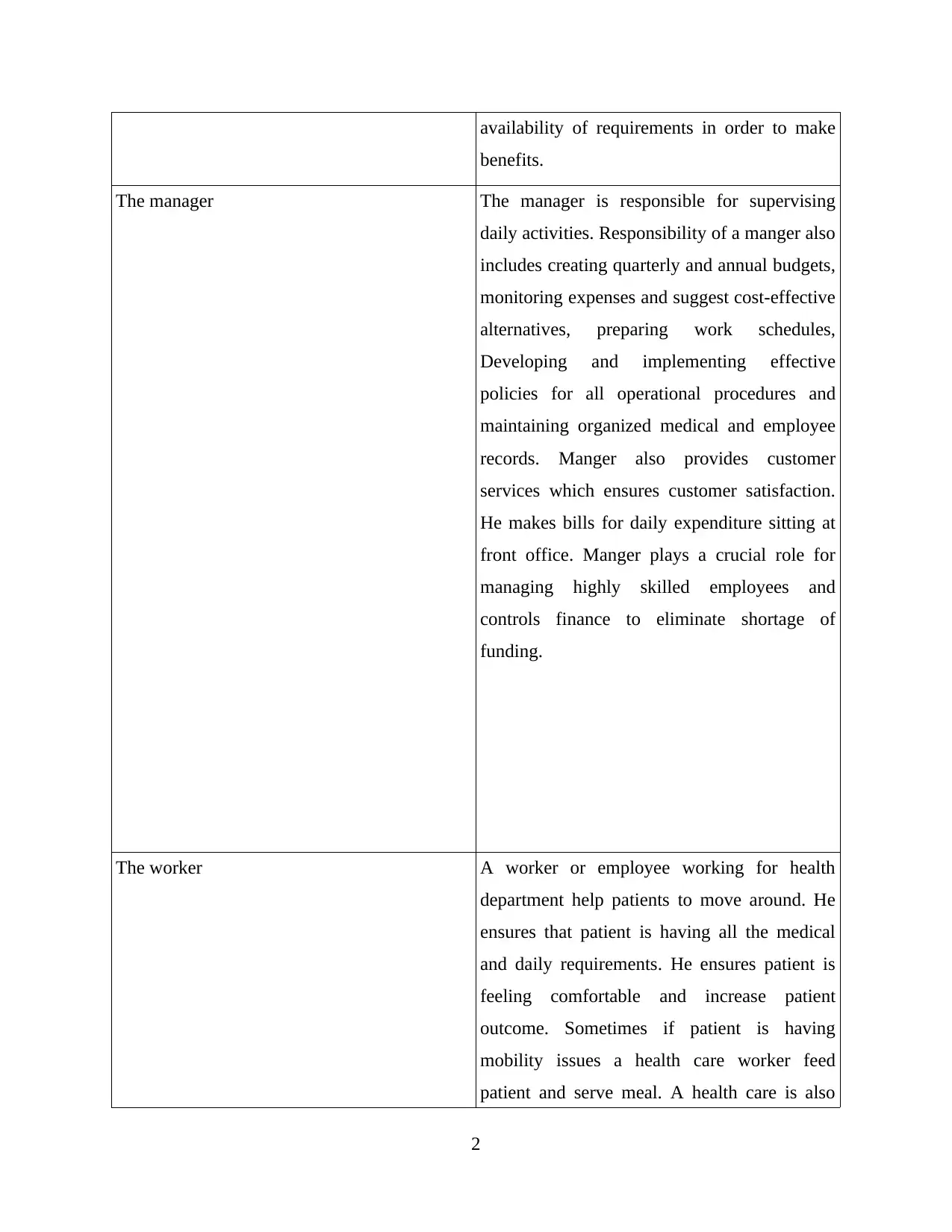
availability of requirements in order to make
benefits.
The manager The manager is responsible for supervising
daily activities. Responsibility of a manger also
includes creating quarterly and annual budgets,
monitoring expenses and suggest cost-effective
alternatives, preparing work schedules,
Developing and implementing effective
policies for all operational procedures and
maintaining organized medical and employee
records. Manger also provides customer
services which ensures customer satisfaction.
He makes bills for daily expenditure sitting at
front office. Manger plays a crucial role for
managing highly skilled employees and
controls finance to eliminate shortage of
funding.
The worker A worker or employee working for health
department help patients to move around. He
ensures that patient is having all the medical
and daily requirements. He ensures patient is
feeling comfortable and increase patient
outcome. Sometimes if patient is having
mobility issues a health care worker feed
patient and serve meal. A health care is also
2
benefits.
The manager The manager is responsible for supervising
daily activities. Responsibility of a manger also
includes creating quarterly and annual budgets,
monitoring expenses and suggest cost-effective
alternatives, preparing work schedules,
Developing and implementing effective
policies for all operational procedures and
maintaining organized medical and employee
records. Manger also provides customer
services which ensures customer satisfaction.
He makes bills for daily expenditure sitting at
front office. Manger plays a crucial role for
managing highly skilled employees and
controls finance to eliminate shortage of
funding.
The worker A worker or employee working for health
department help patients to move around. He
ensures that patient is having all the medical
and daily requirements. He ensures patient is
feeling comfortable and increase patient
outcome. Sometimes if patient is having
mobility issues a health care worker feed
patient and serve meal. A health care is also
2
Paraphrase This Document
Need a fresh take? Get an instant paraphrase of this document with our AI Paraphraser
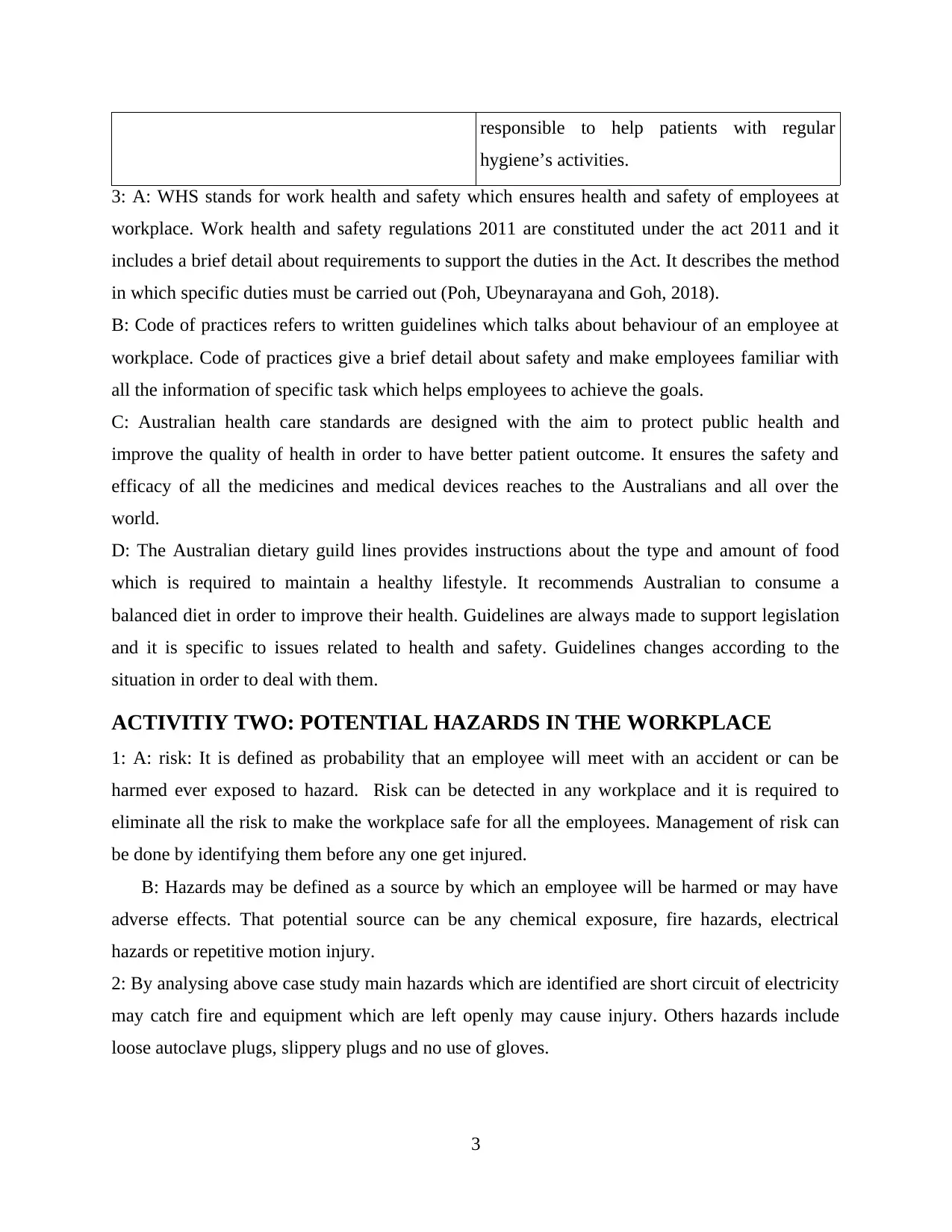
responsible to help patients with regular
hygiene’s activities.
3: A: WHS stands for work health and safety which ensures health and safety of employees at
workplace. Work health and safety regulations 2011 are constituted under the act 2011 and it
includes a brief detail about requirements to support the duties in the Act. It describes the method
in which specific duties must be carried out (Poh, Ubeynarayana and Goh, 2018).
B: Code of practices refers to written guidelines which talks about behaviour of an employee at
workplace. Code of practices give a brief detail about safety and make employees familiar with
all the information of specific task which helps employees to achieve the goals.
C: Australian health care standards are designed with the aim to protect public health and
improve the quality of health in order to have better patient outcome. It ensures the safety and
efficacy of all the medicines and medical devices reaches to the Australians and all over the
world.
D: The Australian dietary guild lines provides instructions about the type and amount of food
which is required to maintain a healthy lifestyle. It recommends Australian to consume a
balanced diet in order to improve their health. Guidelines are always made to support legislation
and it is specific to issues related to health and safety. Guidelines changes according to the
situation in order to deal with them.
ACTIVITIY TWO: POTENTIAL HAZARDS IN THE WORKPLACE
1: A: risk: It is defined as probability that an employee will meet with an accident or can be
harmed ever exposed to hazard. Risk can be detected in any workplace and it is required to
eliminate all the risk to make the workplace safe for all the employees. Management of risk can
be done by identifying them before any one get injured.
B: Hazards may be defined as a source by which an employee will be harmed or may have
adverse effects. That potential source can be any chemical exposure, fire hazards, electrical
hazards or repetitive motion injury.
2: By analysing above case study main hazards which are identified are short circuit of electricity
may catch fire and equipment which are left openly may cause injury. Others hazards include
loose autoclave plugs, slippery plugs and no use of gloves.
3
hygiene’s activities.
3: A: WHS stands for work health and safety which ensures health and safety of employees at
workplace. Work health and safety regulations 2011 are constituted under the act 2011 and it
includes a brief detail about requirements to support the duties in the Act. It describes the method
in which specific duties must be carried out (Poh, Ubeynarayana and Goh, 2018).
B: Code of practices refers to written guidelines which talks about behaviour of an employee at
workplace. Code of practices give a brief detail about safety and make employees familiar with
all the information of specific task which helps employees to achieve the goals.
C: Australian health care standards are designed with the aim to protect public health and
improve the quality of health in order to have better patient outcome. It ensures the safety and
efficacy of all the medicines and medical devices reaches to the Australians and all over the
world.
D: The Australian dietary guild lines provides instructions about the type and amount of food
which is required to maintain a healthy lifestyle. It recommends Australian to consume a
balanced diet in order to improve their health. Guidelines are always made to support legislation
and it is specific to issues related to health and safety. Guidelines changes according to the
situation in order to deal with them.
ACTIVITIY TWO: POTENTIAL HAZARDS IN THE WORKPLACE
1: A: risk: It is defined as probability that an employee will meet with an accident or can be
harmed ever exposed to hazard. Risk can be detected in any workplace and it is required to
eliminate all the risk to make the workplace safe for all the employees. Management of risk can
be done by identifying them before any one get injured.
B: Hazards may be defined as a source by which an employee will be harmed or may have
adverse effects. That potential source can be any chemical exposure, fire hazards, electrical
hazards or repetitive motion injury.
2: By analysing above case study main hazards which are identified are short circuit of electricity
may catch fire and equipment which are left openly may cause injury. Others hazards include
loose autoclave plugs, slippery plugs and no use of gloves.
3
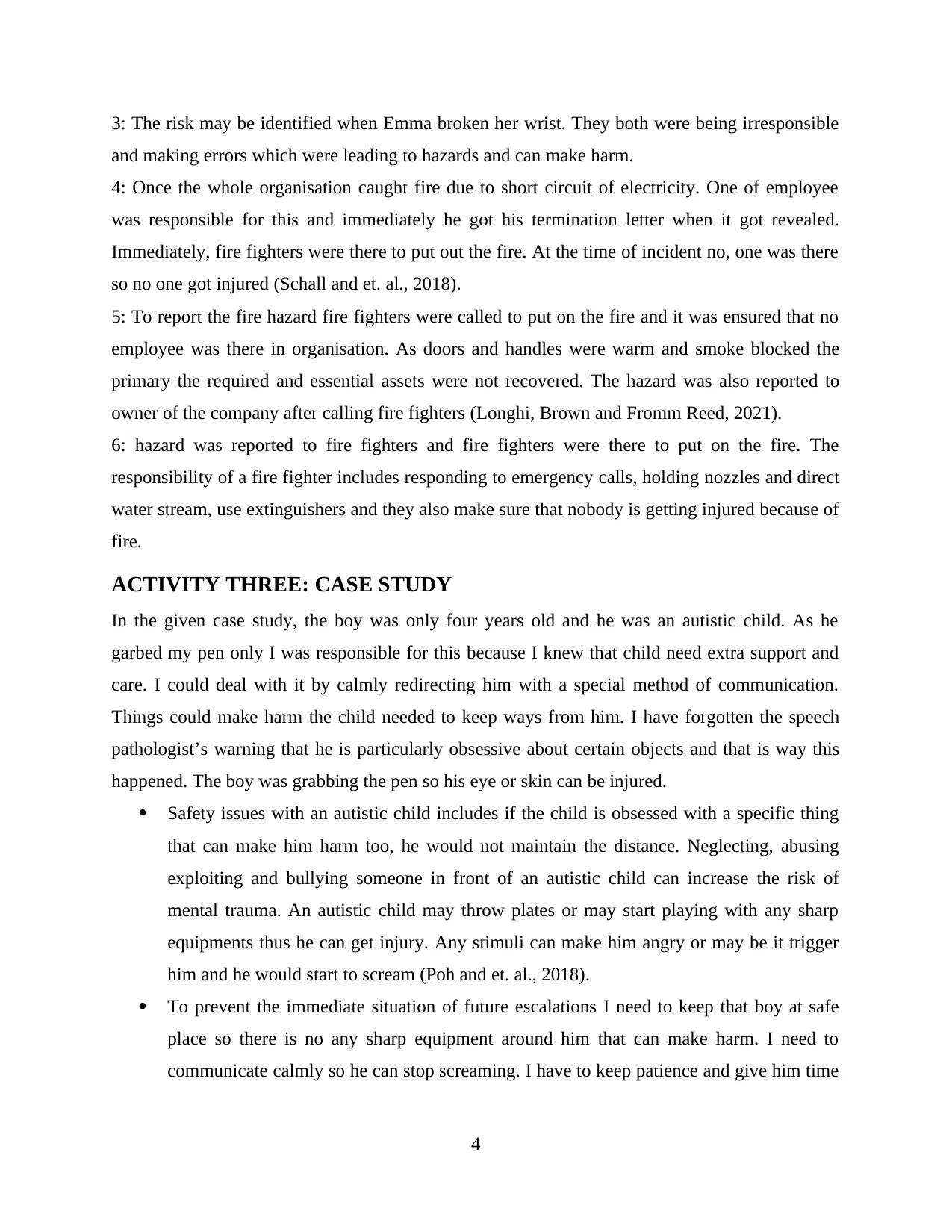
3: The risk may be identified when Emma broken her wrist. They both were being irresponsible
and making errors which were leading to hazards and can make harm.
4: Once the whole organisation caught fire due to short circuit of electricity. One of employee
was responsible for this and immediately he got his termination letter when it got revealed.
Immediately, fire fighters were there to put out the fire. At the time of incident no, one was there
so no one got injured (Schall and et. al., 2018).
5: To report the fire hazard fire fighters were called to put on the fire and it was ensured that no
employee was there in organisation. As doors and handles were warm and smoke blocked the
primary the required and essential assets were not recovered. The hazard was also reported to
owner of the company after calling fire fighters (Longhi, Brown and Fromm Reed, 2021).
6: hazard was reported to fire fighters and fire fighters were there to put on the fire. The
responsibility of a fire fighter includes responding to emergency calls, holding nozzles and direct
water stream, use extinguishers and they also make sure that nobody is getting injured because of
fire.
ACTIVITY THREE: CASE STUDY
In the given case study, the boy was only four years old and he was an autistic child. As he
garbed my pen only I was responsible for this because I knew that child need extra support and
care. I could deal with it by calmly redirecting him with a special method of communication.
Things could make harm the child needed to keep ways from him. I have forgotten the speech
pathologist’s warning that he is particularly obsessive about certain objects and that is way this
happened. The boy was grabbing the pen so his eye or skin can be injured.
Safety issues with an autistic child includes if the child is obsessed with a specific thing
that can make him harm too, he would not maintain the distance. Neglecting, abusing
exploiting and bullying someone in front of an autistic child can increase the risk of
mental trauma. An autistic child may throw plates or may start playing with any sharp
equipments thus he can get injury. Any stimuli can make him angry or may be it trigger
him and he would start to scream (Poh and et. al., 2018).
To prevent the immediate situation of future escalations I need to keep that boy at safe
place so there is no any sharp equipment around him that can make harm. I need to
communicate calmly so he can stop screaming. I have to keep patience and give him time
4
and making errors which were leading to hazards and can make harm.
4: Once the whole organisation caught fire due to short circuit of electricity. One of employee
was responsible for this and immediately he got his termination letter when it got revealed.
Immediately, fire fighters were there to put out the fire. At the time of incident no, one was there
so no one got injured (Schall and et. al., 2018).
5: To report the fire hazard fire fighters were called to put on the fire and it was ensured that no
employee was there in organisation. As doors and handles were warm and smoke blocked the
primary the required and essential assets were not recovered. The hazard was also reported to
owner of the company after calling fire fighters (Longhi, Brown and Fromm Reed, 2021).
6: hazard was reported to fire fighters and fire fighters were there to put on the fire. The
responsibility of a fire fighter includes responding to emergency calls, holding nozzles and direct
water stream, use extinguishers and they also make sure that nobody is getting injured because of
fire.
ACTIVITY THREE: CASE STUDY
In the given case study, the boy was only four years old and he was an autistic child. As he
garbed my pen only I was responsible for this because I knew that child need extra support and
care. I could deal with it by calmly redirecting him with a special method of communication.
Things could make harm the child needed to keep ways from him. I have forgotten the speech
pathologist’s warning that he is particularly obsessive about certain objects and that is way this
happened. The boy was grabbing the pen so his eye or skin can be injured.
Safety issues with an autistic child includes if the child is obsessed with a specific thing
that can make him harm too, he would not maintain the distance. Neglecting, abusing
exploiting and bullying someone in front of an autistic child can increase the risk of
mental trauma. An autistic child may throw plates or may start playing with any sharp
equipments thus he can get injury. Any stimuli can make him angry or may be it trigger
him and he would start to scream (Poh and et. al., 2018).
To prevent the immediate situation of future escalations I need to keep that boy at safe
place so there is no any sharp equipment around him that can make harm. I need to
communicate calmly so he can stop screaming. I have to keep patience and give him time
4
⊘ This is a preview!⊘
Do you want full access?
Subscribe today to unlock all pages.

Trusted by 1+ million students worldwide
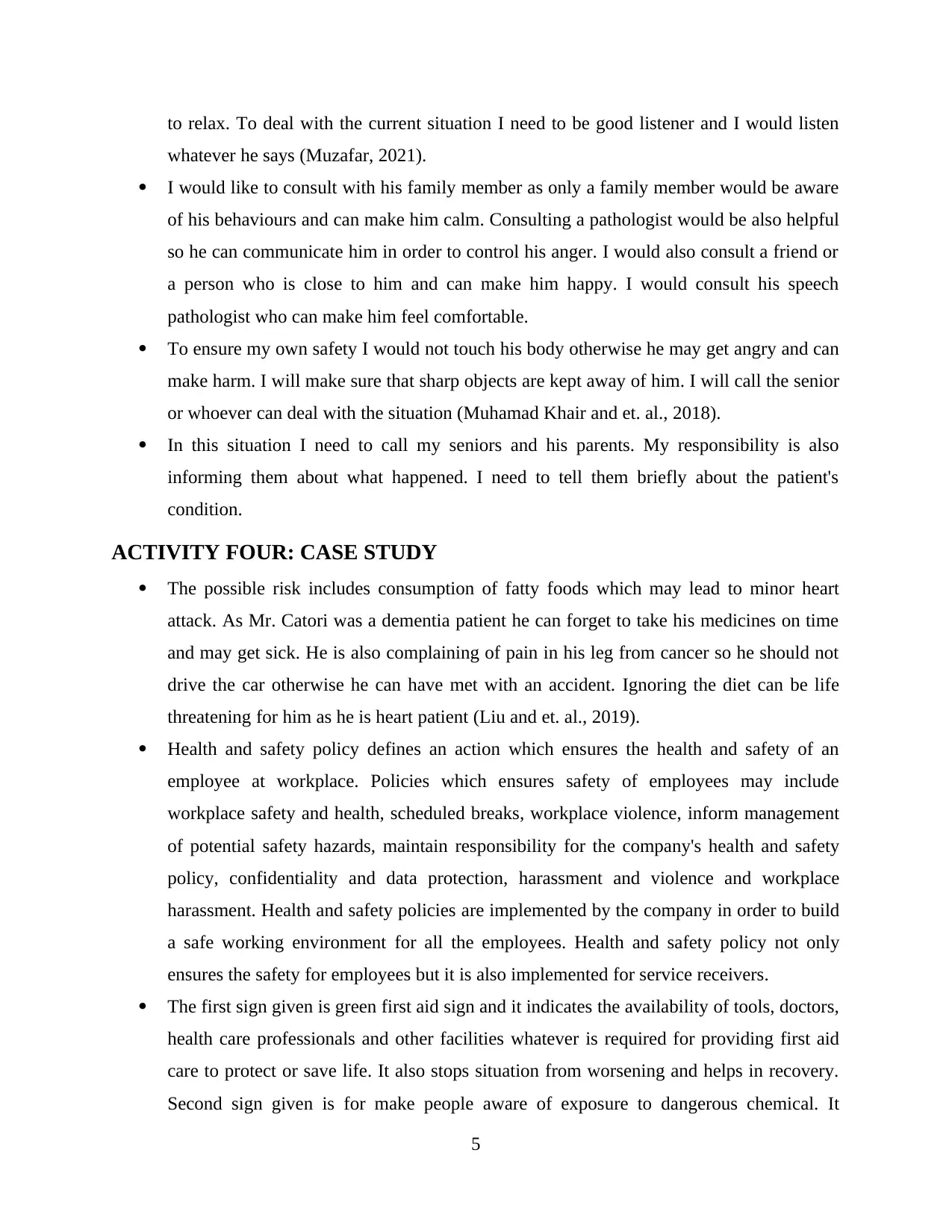
to relax. To deal with the current situation I need to be good listener and I would listen
whatever he says (Muzafar, 2021).
I would like to consult with his family member as only a family member would be aware
of his behaviours and can make him calm. Consulting a pathologist would be also helpful
so he can communicate him in order to control his anger. I would also consult a friend or
a person who is close to him and can make him happy. I would consult his speech
pathologist who can make him feel comfortable.
To ensure my own safety I would not touch his body otherwise he may get angry and can
make harm. I will make sure that sharp objects are kept away of him. I will call the senior
or whoever can deal with the situation (Muhamad Khair and et. al., 2018).
In this situation I need to call my seniors and his parents. My responsibility is also
informing them about what happened. I need to tell them briefly about the patient's
condition.
ACTIVITY FOUR: CASE STUDY
The possible risk includes consumption of fatty foods which may lead to minor heart
attack. As Mr. Catori was a dementia patient he can forget to take his medicines on time
and may get sick. He is also complaining of pain in his leg from cancer so he should not
drive the car otherwise he can have met with an accident. Ignoring the diet can be life
threatening for him as he is heart patient (Liu and et. al., 2019).
Health and safety policy defines an action which ensures the health and safety of an
employee at workplace. Policies which ensures safety of employees may include
workplace safety and health, scheduled breaks, workplace violence, inform management
of potential safety hazards, maintain responsibility for the company's health and safety
policy, confidentiality and data protection, harassment and violence and workplace
harassment. Health and safety policies are implemented by the company in order to build
a safe working environment for all the employees. Health and safety policy not only
ensures the safety for employees but it is also implemented for service receivers.
The first sign given is green first aid sign and it indicates the availability of tools, doctors,
health care professionals and other facilities whatever is required for providing first aid
care to protect or save life. It also stops situation from worsening and helps in recovery.
Second sign given is for make people aware of exposure to dangerous chemical. It
5
whatever he says (Muzafar, 2021).
I would like to consult with his family member as only a family member would be aware
of his behaviours and can make him calm. Consulting a pathologist would be also helpful
so he can communicate him in order to control his anger. I would also consult a friend or
a person who is close to him and can make him happy. I would consult his speech
pathologist who can make him feel comfortable.
To ensure my own safety I would not touch his body otherwise he may get angry and can
make harm. I will make sure that sharp objects are kept away of him. I will call the senior
or whoever can deal with the situation (Muhamad Khair and et. al., 2018).
In this situation I need to call my seniors and his parents. My responsibility is also
informing them about what happened. I need to tell them briefly about the patient's
condition.
ACTIVITY FOUR: CASE STUDY
The possible risk includes consumption of fatty foods which may lead to minor heart
attack. As Mr. Catori was a dementia patient he can forget to take his medicines on time
and may get sick. He is also complaining of pain in his leg from cancer so he should not
drive the car otherwise he can have met with an accident. Ignoring the diet can be life
threatening for him as he is heart patient (Liu and et. al., 2019).
Health and safety policy defines an action which ensures the health and safety of an
employee at workplace. Policies which ensures safety of employees may include
workplace safety and health, scheduled breaks, workplace violence, inform management
of potential safety hazards, maintain responsibility for the company's health and safety
policy, confidentiality and data protection, harassment and violence and workplace
harassment. Health and safety policies are implemented by the company in order to build
a safe working environment for all the employees. Health and safety policy not only
ensures the safety for employees but it is also implemented for service receivers.
The first sign given is green first aid sign and it indicates the availability of tools, doctors,
health care professionals and other facilities whatever is required for providing first aid
care to protect or save life. It also stops situation from worsening and helps in recovery.
Second sign given is for make people aware of exposure to dangerous chemical. It
5
Paraphrase This Document
Need a fresh take? Get an instant paraphrase of this document with our AI Paraphraser
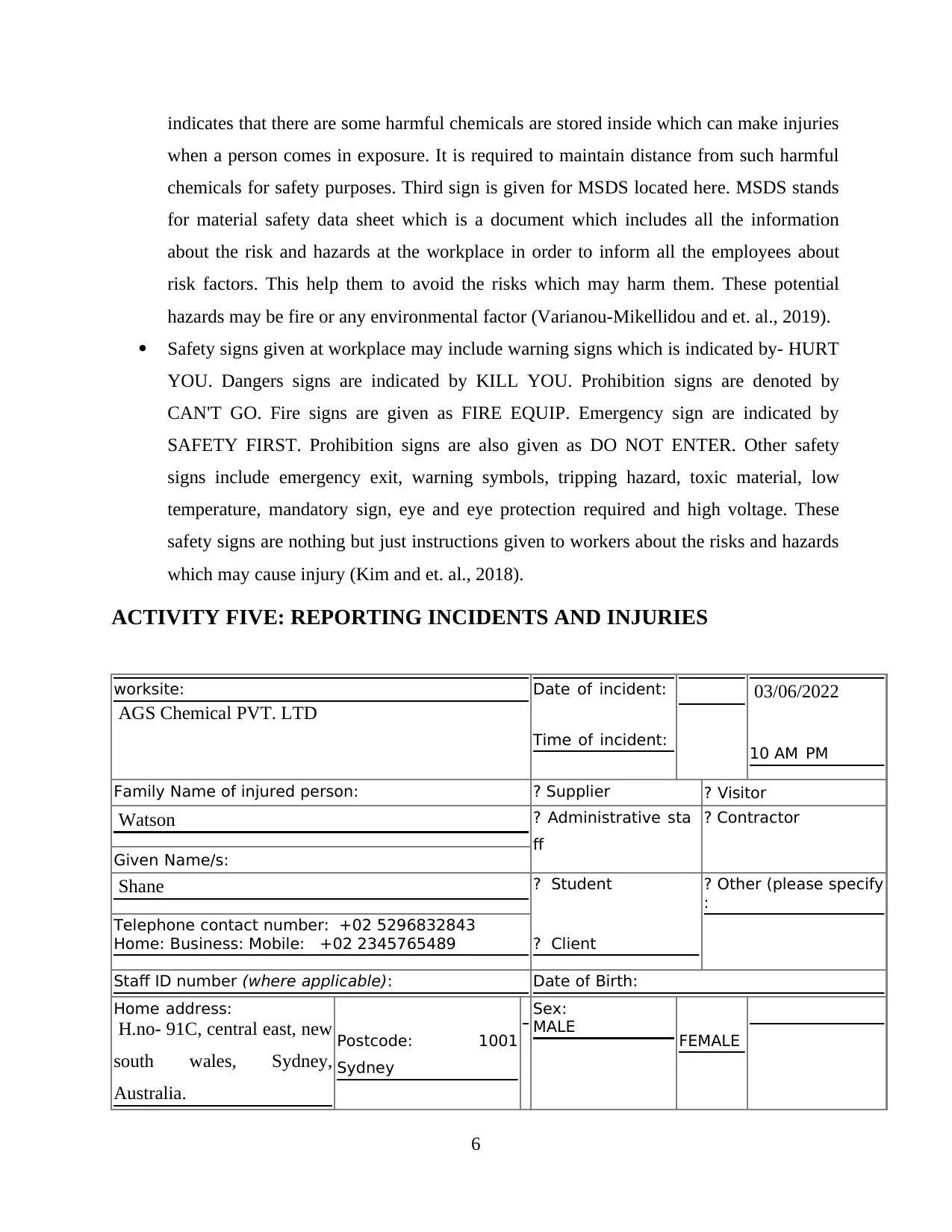
indicates that there are some harmful chemicals are stored inside which can make injuries
when a person comes in exposure. It is required to maintain distance from such harmful
chemicals for safety purposes. Third sign is given for MSDS located here. MSDS stands
for material safety data sheet which is a document which includes all the information
about the risk and hazards at the workplace in order to inform all the employees about
risk factors. This help them to avoid the risks which may harm them. These potential
hazards may be fire or any environmental factor (Varianou-Mikellidou and et. al., 2019).
Safety signs given at workplace may include warning signs which is indicated by- HURT
YOU. Dangers signs are indicated by KILL YOU. Prohibition signs are denoted by
CAN'T GO. Fire signs are given as FIRE EQUIP. Emergency sign are indicated by
SAFETY FIRST. Prohibition signs are also given as DO NOT ENTER. Other safety
signs include emergency exit, warning symbols, tripping hazard, toxic material, low
temperature, mandatory sign, eye and eye protection required and high voltage. These
safety signs are nothing but just instructions given to workers about the risks and hazards
which may cause injury (Kim and et. al., 2018).
ACTIVITY FIVE: REPORTING INCIDENTS AND INJURIES
worksite:
AGS Chemical PVT. LTD
Date of incident:
Time of incident:
03/06/2022
10 AM PM
Family Name of injured person: ? Supplier ? Visitor
Watson ? Administrative sta
ff
? Contractor
Given Name/s:
Shane ? Student
? Client
? Other (please specify
:
Telephone contact number: +02 5296832843
Home: Business: Mobile: +02 2345765489
Staff ID number (where applicable): Date of Birth:
Home address:
H.no- 91C, central east, new
south wales, Sydney,
Australia.
Postcode: 1001
Sydney
Sex:
MALE FEMALE
6
when a person comes in exposure. It is required to maintain distance from such harmful
chemicals for safety purposes. Third sign is given for MSDS located here. MSDS stands
for material safety data sheet which is a document which includes all the information
about the risk and hazards at the workplace in order to inform all the employees about
risk factors. This help them to avoid the risks which may harm them. These potential
hazards may be fire or any environmental factor (Varianou-Mikellidou and et. al., 2019).
Safety signs given at workplace may include warning signs which is indicated by- HURT
YOU. Dangers signs are indicated by KILL YOU. Prohibition signs are denoted by
CAN'T GO. Fire signs are given as FIRE EQUIP. Emergency sign are indicated by
SAFETY FIRST. Prohibition signs are also given as DO NOT ENTER. Other safety
signs include emergency exit, warning symbols, tripping hazard, toxic material, low
temperature, mandatory sign, eye and eye protection required and high voltage. These
safety signs are nothing but just instructions given to workers about the risks and hazards
which may cause injury (Kim and et. al., 2018).
ACTIVITY FIVE: REPORTING INCIDENTS AND INJURIES
worksite:
AGS Chemical PVT. LTD
Date of incident:
Time of incident:
03/06/2022
10 AM PM
Family Name of injured person: ? Supplier ? Visitor
Watson ? Administrative sta
ff
? Contractor
Given Name/s:
Shane ? Student
? Client
? Other (please specify
:
Telephone contact number: +02 5296832843
Home: Business: Mobile: +02 2345765489
Staff ID number (where applicable): Date of Birth:
Home address:
H.no- 91C, central east, new
south wales, Sydney,
Australia.
Postcode: 1001
Sydney
Sex:
MALE FEMALE
6
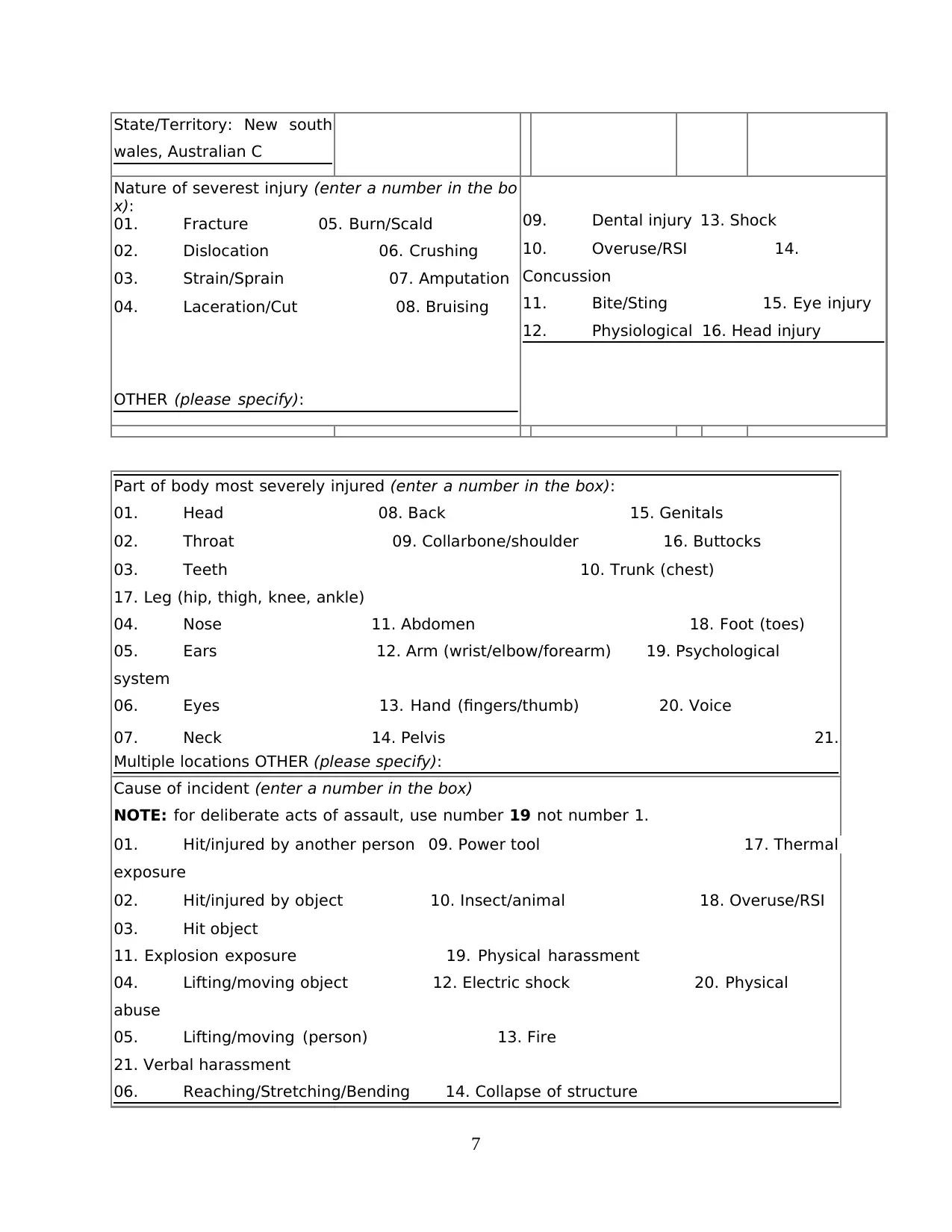
State/Territory: New south
wales, Australian C
Nature of severest injury (enter a number in the bo
x):
01. Fracture 05. Burn/Scald
02. Dislocation 06. Crushing
03. Strain/Sprain 07. Amputation
04. Laceration/Cut 08. Bruising
OTHER (please specify):
09. Dental injury 13. Shock
10. Overuse/RSI 14.
Concussion
11. Bite/Sting 15. Eye injury
12. Physiological 16. Head injury
Part of body most severely injured (enter a number in the box):
01. Head 08. Back 15. Genitals
02. Throat 09. Collarbone/shoulder 16. Buttocks
03. Teeth 10. Trunk (chest)
17. Leg (hip, thigh, knee, ankle)
04. Nose 11. Abdomen 18. Foot (toes)
05. Ears 12. Arm (wrist/elbow/forearm) 19. Psychological
system
06. Eyes 13. Hand (fingers/thumb) 20. Voice
07. Neck 14. Pelvis 21.
Multiple locations OTHER (please specify):
Cause of incident (enter a number in the box)
NOTE: for deliberate acts of assault, use number 19 not number 1.
01. Hit/injured by another person 09. Power tool 17. Thermal
exposure
02. Hit/injured by object 10. Insect/animal 18. Overuse/RSI
03. Hit object
11. Explosion exposure 19. Physical harassment
04. Lifting/moving object 12. Electric shock 20. Physical
abuse
05. Lifting/moving (person) 13. Fire
21. Verbal harassment
06. Reaching/Stretching/Bending 14. Collapse of structure
7
wales, Australian C
Nature of severest injury (enter a number in the bo
x):
01. Fracture 05. Burn/Scald
02. Dislocation 06. Crushing
03. Strain/Sprain 07. Amputation
04. Laceration/Cut 08. Bruising
OTHER (please specify):
09. Dental injury 13. Shock
10. Overuse/RSI 14.
Concussion
11. Bite/Sting 15. Eye injury
12. Physiological 16. Head injury
Part of body most severely injured (enter a number in the box):
01. Head 08. Back 15. Genitals
02. Throat 09. Collarbone/shoulder 16. Buttocks
03. Teeth 10. Trunk (chest)
17. Leg (hip, thigh, knee, ankle)
04. Nose 11. Abdomen 18. Foot (toes)
05. Ears 12. Arm (wrist/elbow/forearm) 19. Psychological
system
06. Eyes 13. Hand (fingers/thumb) 20. Voice
07. Neck 14. Pelvis 21.
Multiple locations OTHER (please specify):
Cause of incident (enter a number in the box)
NOTE: for deliberate acts of assault, use number 19 not number 1.
01. Hit/injured by another person 09. Power tool 17. Thermal
exposure
02. Hit/injured by object 10. Insect/animal 18. Overuse/RSI
03. Hit object
11. Explosion exposure 19. Physical harassment
04. Lifting/moving object 12. Electric shock 20. Physical
abuse
05. Lifting/moving (person) 13. Fire
21. Verbal harassment
06. Reaching/Stretching/Bending 14. Collapse of structure
7
⊘ This is a preview!⊘
Do you want full access?
Subscribe today to unlock all pages.

Trusted by 1+ million students worldwide
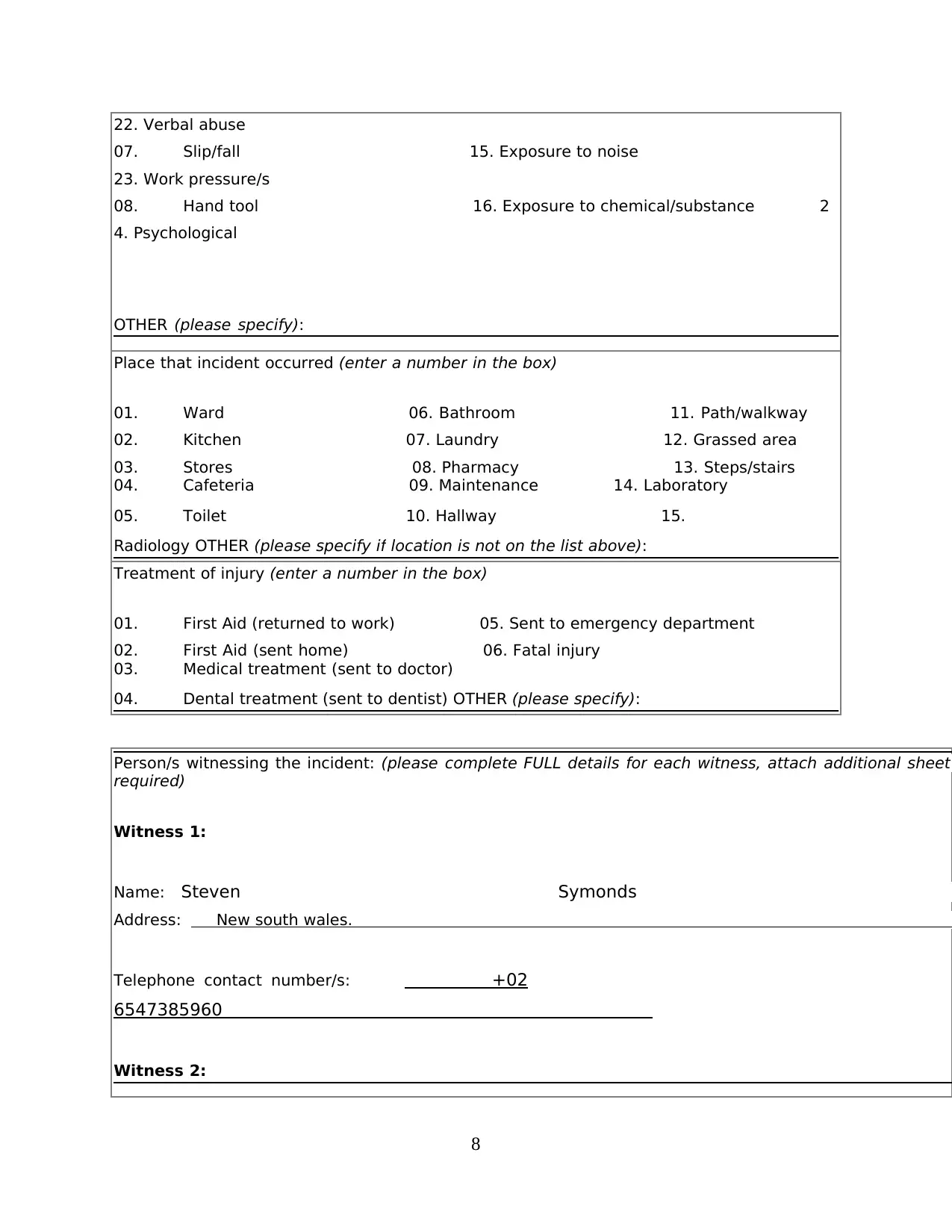
22. Verbal abuse
07. Slip/fall 15. Exposure to noise
23. Work pressure/s
08. Hand tool 16. Exposure to chemical/substance 2
4. Psychological
OTHER (please specify):
Place that incident occurred (enter a number in the box)
01. Ward 06. Bathroom 11. Path/walkway
02. Kitchen 07. Laundry 12. Grassed area
03. Stores 08. Pharmacy 13. Steps/stairs
04. Cafeteria 09. Maintenance 14. Laboratory
05. Toilet 10. Hallway 15.
Radiology OTHER (please specify if location is not on the list above):
Treatment of injury (enter a number in the box)
01. First Aid (returned to work) 05. Sent to emergency department
02. First Aid (sent home) 06. Fatal injury
03. Medical treatment (sent to doctor)
04. Dental treatment (sent to dentist) OTHER (please specify):
Person/s witnessing the incident: (please complete FULL details for each witness, attach additional sheet
required)
Witness 1:
Name: Steven Symonds
Address: New south wales.
Telephone contact number/s: +02
6547385960
Witness 2:
8
07. Slip/fall 15. Exposure to noise
23. Work pressure/s
08. Hand tool 16. Exposure to chemical/substance 2
4. Psychological
OTHER (please specify):
Place that incident occurred (enter a number in the box)
01. Ward 06. Bathroom 11. Path/walkway
02. Kitchen 07. Laundry 12. Grassed area
03. Stores 08. Pharmacy 13. Steps/stairs
04. Cafeteria 09. Maintenance 14. Laboratory
05. Toilet 10. Hallway 15.
Radiology OTHER (please specify if location is not on the list above):
Treatment of injury (enter a number in the box)
01. First Aid (returned to work) 05. Sent to emergency department
02. First Aid (sent home) 06. Fatal injury
03. Medical treatment (sent to doctor)
04. Dental treatment (sent to dentist) OTHER (please specify):
Person/s witnessing the incident: (please complete FULL details for each witness, attach additional sheet
required)
Witness 1:
Name: Steven Symonds
Address: New south wales.
Telephone contact number/s: +02
6547385960
Witness 2:
8
Paraphrase This Document
Need a fresh take? Get an instant paraphrase of this document with our AI Paraphraser
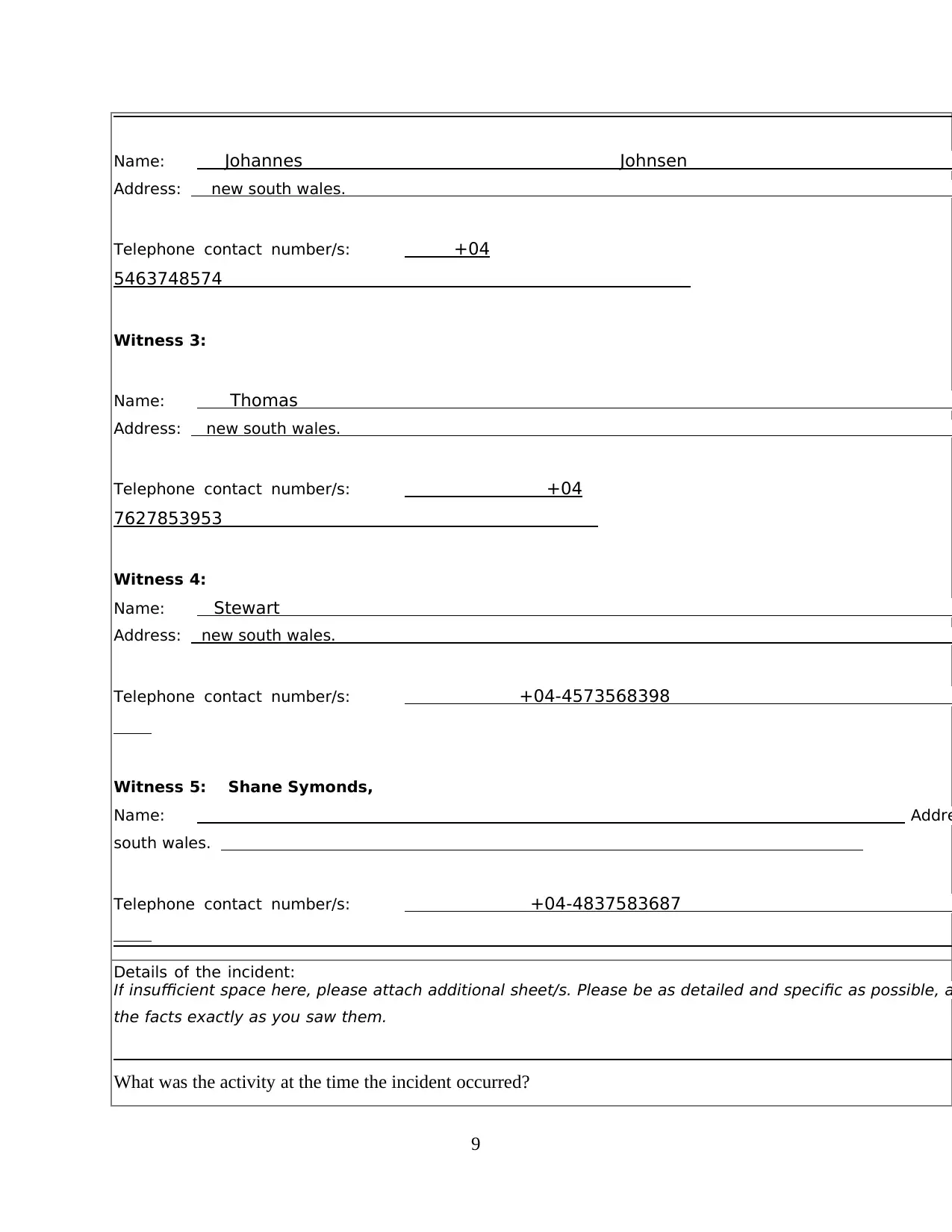
Name: Johannes Johnsen
Address: new south wales.
Telephone contact number/s: +04
5463748574
Witness 3:
Name: Thomas
Address: new south wales.
Telephone contact number/s: +04
7627853953
Witness 4:
Name: Stewart
Address: new south wales.
Telephone contact number/s: +04-4573568398
Witness 5: Shane Symonds,
Name: Addre
south wales.
Telephone contact number/s: +04-4837583687
Details of the incident:
If insufficient space here, please attach additional sheet/s. Please be as detailed and specific as possible, a
the facts exactly as you saw them.
What was the activity at the time the incident occurred?
9
Address: new south wales.
Telephone contact number/s: +04
5463748574
Witness 3:
Name: Thomas
Address: new south wales.
Telephone contact number/s: +04
7627853953
Witness 4:
Name: Stewart
Address: new south wales.
Telephone contact number/s: +04-4573568398
Witness 5: Shane Symonds,
Name: Addre
south wales.
Telephone contact number/s: +04-4837583687
Details of the incident:
If insufficient space here, please attach additional sheet/s. Please be as detailed and specific as possible, a
the facts exactly as you saw them.
What was the activity at the time the incident occurred?
9
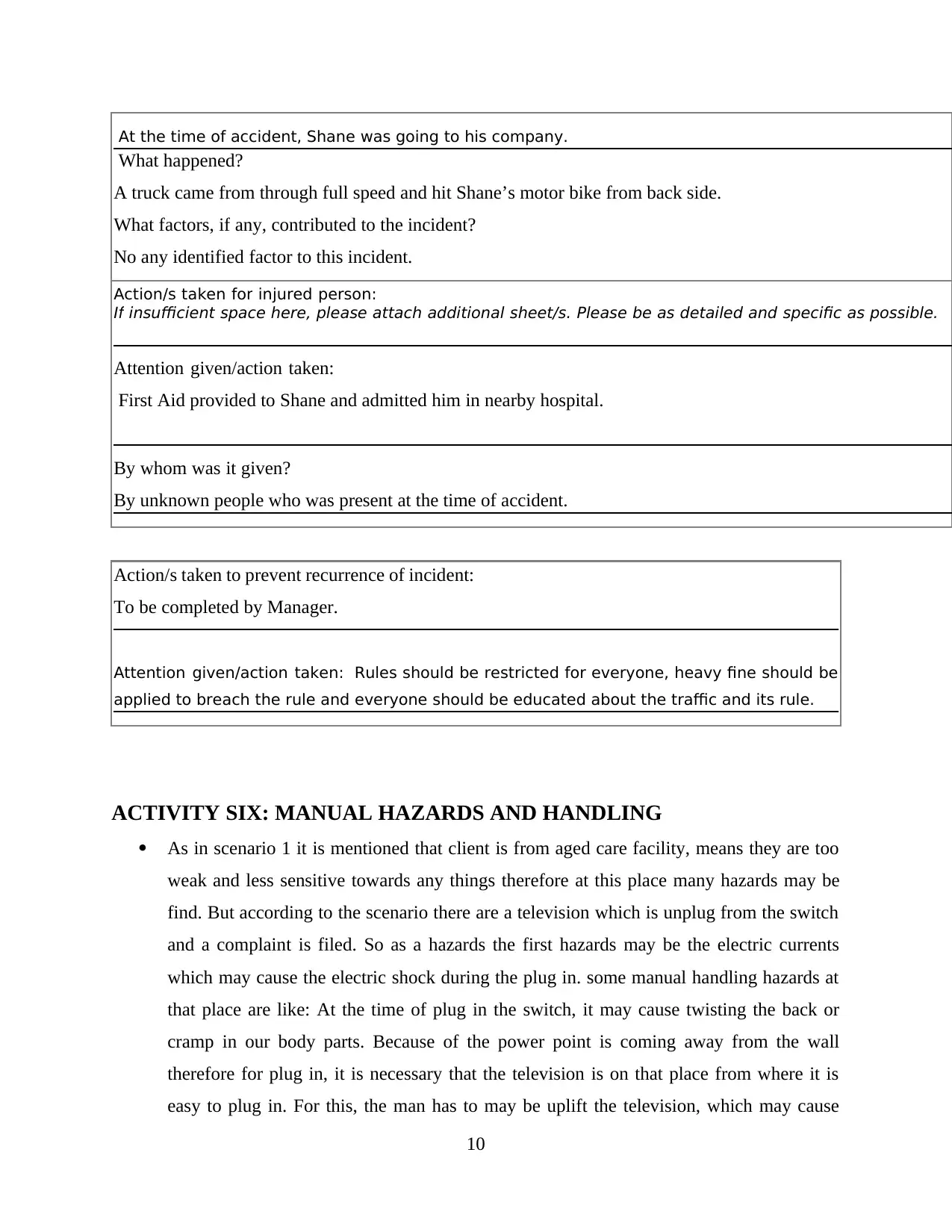
At the time of accident, Shane was going to his company.
What happened?
A truck came from through full speed and hit Shane’s motor bike from back side.
What factors, if any, contributed to the incident?
No any identified factor to this incident.
Action/s taken for injured person:
If insufficient space here, please attach additional sheet/s. Please be as detailed and specific as possible.
Attention given/action taken:
First Aid provided to Shane and admitted him in nearby hospital.
By whom was it given?
By unknown people who was present at the time of accident.
Action/s taken to prevent recurrence of incident:
To be completed by Manager.
Attention given/action taken: Rules should be restricted for everyone, heavy fine should be
applied to breach the rule and everyone should be educated about the traffic and its rule.
ACTIVITY SIX: MANUAL HAZARDS AND HANDLING
As in scenario 1 it is mentioned that client is from aged care facility, means they are too
weak and less sensitive towards any things therefore at this place many hazards may be
find. But according to the scenario there are a television which is unplug from the switch
and a complaint is filed. So as a hazards the first hazards may be the electric currents
which may cause the electric shock during the plug in. some manual handling hazards at
that place are like: At the time of plug in the switch, it may cause twisting the back or
cramp in our body parts. Because of the power point is coming away from the wall
therefore for plug in, it is necessary that the television is on that place from where it is
easy to plug in. For this, the man has to may be uplift the television, which may cause
10
What happened?
A truck came from through full speed and hit Shane’s motor bike from back side.
What factors, if any, contributed to the incident?
No any identified factor to this incident.
Action/s taken for injured person:
If insufficient space here, please attach additional sheet/s. Please be as detailed and specific as possible.
Attention given/action taken:
First Aid provided to Shane and admitted him in nearby hospital.
By whom was it given?
By unknown people who was present at the time of accident.
Action/s taken to prevent recurrence of incident:
To be completed by Manager.
Attention given/action taken: Rules should be restricted for everyone, heavy fine should be
applied to breach the rule and everyone should be educated about the traffic and its rule.
ACTIVITY SIX: MANUAL HAZARDS AND HANDLING
As in scenario 1 it is mentioned that client is from aged care facility, means they are too
weak and less sensitive towards any things therefore at this place many hazards may be
find. But according to the scenario there are a television which is unplug from the switch
and a complaint is filed. So as a hazards the first hazards may be the electric currents
which may cause the electric shock during the plug in. some manual handling hazards at
that place are like: At the time of plug in the switch, it may cause twisting the back or
cramp in our body parts. Because of the power point is coming away from the wall
therefore for plug in, it is necessary that the television is on that place from where it is
easy to plug in. For this, the man has to may be uplift the television, which may cause
10
⊘ This is a preview!⊘
Do you want full access?
Subscribe today to unlock all pages.

Trusted by 1+ million students worldwide
1 out of 29
Related Documents
Your All-in-One AI-Powered Toolkit for Academic Success.
+13062052269
info@desklib.com
Available 24*7 on WhatsApp / Email
![[object Object]](/_next/static/media/star-bottom.7253800d.svg)
Unlock your academic potential
Copyright © 2020–2025 A2Z Services. All Rights Reserved. Developed and managed by ZUCOL.





